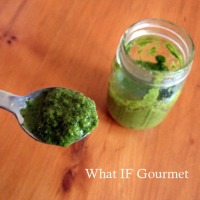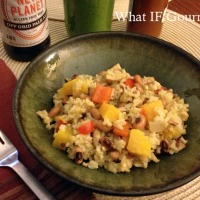You may be wondering what items stock the pantry of someone on a gluten-free, dairy-free, low-sugar, minimally-processed-foods eating plan. So, I’m opening up a glimpse into my pantry, with the caveat that these items reflect not only the basic principles of an “anti-inflammatory” eating plan, but also my own allergens (gluten, dairy), and my personal tastes. For example, lots of folks like to use stevia or maple syrup as alternative sweeteners, but I personally don’t enjoy their flavor in foods, so I don’t stock them in my pantry. Consider this simply a snapshot of one individual’s approach to healthy eating — an approach that, through trial and error, I have found works for me. I hope you find some inspiration here in designing your own ideal eating plan that works for you.
Sweeteners
Raw buckwheat honey
Sorghum syrup or molasses
Medjool dates
Prunes
Coconut sugar
Dark chocolate (65% or more cacoa content)
Sugar is still sugar, whether it’s in the form of refined white sugar, honey, or molasses. I like to add pureed medjool dates or other dried fruit to recipes in place of granulated or liquid sugars. I’m not kidding myself — I know I am still adding sugar, but the fiber in dried fruits helps regulate the absorption of that sugar, mitigating spikes in blood sugar, and also makes me feel full faster so I’m not as tempted to over-indulge. I prefer to buy medjool dates with the pit still in them from our local Middle Eastern market. These medjool dates are huge, sticky, and soft enough to pull apart with my fingers, unlike the dried-out, already-pitted deglet noor dates I regularly see at our big chain grocery store. If I lived someplace different, then perhaps the deglet noor dates would be better. For the purpose of following the recipes on this blog, I recommend using the largest, softest, stickiest dates you can find, whatever the variety.
Spices and Extracts
My spice drawer has over 70 different herbs and spices in it, because I love experimenting with different flavors profiles. However, they are also a great source of micronutrients and anti-inflammatory compounds like curcumin, which is found in turmeric. Some of the most important spices in my cupboard are turmeric, cumin, ginger, cinnamon, paprika (sweet and smoked), black pepper, and cayenne. I also like to add extracts and flavoring oils to my food and beverages. A few drops of peppermint or orange oil mixed with almond milk in a brewed mocha elevates my morning beverage to a special coffee drink without the sugars and chemicals that lace coffee shop drinks. The flavorings I regularly keep on hand include vanilla bean paste, vanilla extract, coconut extract (propylene glycol free), almond extract, peppermint oil, orange oil, and lemon oil.
Protein
Grass-fed ground bison
Free-range, hormone-free poultry
Salmon burgers (gluten free)
Local eggs (free-range, hormone-free)
Silken tofu
Brown rice or egg-white protein powder (for smoothies)
Since the Gent does not care for tofu, I generally cook with it only when I am pureeing it into a dip or sauce, where its presence is incognito. We actually eat very little meat, perhaps once a week at most, relying instead on nuts, seeds, and legumes for most of our protein needs. I’m the true carnivore in our family, but even I acknowledge that I feel better on a mostly plant-based diet. There would be a lot more fish and shellfish on this list if I still lived in New England, but since we live in Iowa, fresh fish just isn’t an easily accessible or economical option for us.
Fresh and Frozen Produce
Bananas
Citrus
Seasonal snacking fruit
Frozen fruit (peaches, cherries, strawberries, blueberries, grapes)
Frozen vegetables (peas, corn, broccoli, etc.)
Fresh herbs (can be frozen to prolong their storage life)
Brassicas (broccoli, cauliflower, brussel sprouts, cabbage)
Greens (kale, swiss chard, baby spinach, etc.)
Carrots
Cucumbers
Peppers (sweet bell and spicy)
Mushrooms (we usually default to crimini – a.k.a. “brown button” – mushrooms)
Squashes
I like to snack on bananas (especially with peanut butter) because they give me a carby comfort I often miss in this gluten-free life. Eating lots of fruits and vegetables is one of the most important parts of an anti-inflammatory eating plan, and we enjoy them daily as snacks and in our meals. I also add vegetables such as greens, carrots, broccoli, and cucumbers to daily breakfast smoothies along with frozen fruit; it’s a great way to get some extra servings of vegetables in each day. We always have several bags of frozen fruit on hand for smoothies, sauces, and to put in or on gluten-free pancakes. Frozen vegetables mean we always have something to fall back on even when we run out of fresh produce.
Aromatics
Garlic
Onions
Ginger root
Alliums like garlic and onions are high in anti-inflammatory compounds, as is ginger root. Plus, they add lots of great flavor to a dish. I cook with aromatics every single day.
Root Vegetables
Sweet potatoes
Purple potatoes
Turnips
Rutabagas
Beets
Carrots
We always have at least one type of root vegetable stashed in a cool, dark spot in our pantry, at the ready for roasting or mashing as a quick side-dish, or for adding to soups and stews.
Gluten-Free Flours
Almond flour (grain free)
Bob’s Red Mill Gluten Free All-Purpose Flour (contains legumes)
Cassava flour (grain free)
Chickpea flour (a.k.a. besan; also grain free)
Cocoa powder (unsweetened, “Natural” vs. Dutch-processed, grain free)
Coconut flour (grain free)
Corn starch
GF Oat flour
Sweet Sorghum Flour
Tapioca starch (from the same plant as cassava flour, but a finer texture, also grain free)
Any sort of gluten-free baking demands an arsenal of flours to mimic the various properties of wheat flour. And every flour has its own flavor and characteristics, so only experimentation can teach you which you like best. This list includes the flours I always try to have on hand, to mix together in different combinations and proportions depending on the recipe.
Cooking Liquids and Beverages
Almond milk
100% fruit juice (no added sweeteners; for smoothies rather than drinking straight up)
Coconut milk (canned)
Chicken and/or vegetable broth (gluten free)
Marsala wine
Madeira wine
Flavored bubbly water (no sweeteners, just flavor: Canada Dry and La Croix)
Green tea
Crio Bru
Coffee (I limit myself to one 8-oz. cup per day, since it can exacerbate the dry mouth symptoms of Sjogren’s Syndrome)
Nuts and Seeds
Raw cashews
Pistachios
Almonds
Pecans
Natural peanut butter
Sunflower seed butter
Dry-roasted peanuts
Pumpkin seeds
Sesame seeds
Sunflower seeds
Flax seeds (whole)
Flax seeds (ground)
The Gent is allergic to walnuts, so we substitute pecans in recipes that call for a strong- flavored but soft-textured nut. Raw cashews are an essential for making dairy-free cream sauces. We snack on pistachios, almonds, peanuts, and seeds, and also add them to baked goods and hot oatmeal. I add ground flax to our breakfast smoothies for a boost of omega-3s.
Fats and Oils
Olive oil (virgin, cold-pressed)
Grapeseed oil (unrefined)
Sesame oil*
Flax oil*
Coconut oil (unrefined)
Vegan buttery spread
It’s important to get enough “good” fats in your diet in general, but especially if you are struggling with inflammation or autoimmune disease. I try to stick with monounsaturated oils, and oils which have not been heavily refined (which is why I avoid canola oil). Coconut oil is a great butter substitute because it is solid at cool room temperature (or when chilled), so it performs in ways that monounsaturated oils can’t. It also contains medium-chain saturated fats which are starting to get some positive attention in the nutrition research literature. When I want a buttery flavor, I turn to omega-3 fortified vegan “buttery spread” that is trans fat free (such as Earth Balance).
* Sesame oil and flax oil have extremely low smoke points, so they should not be used during cooking. Add to a dish after it is cooked, or use cold, such as in salad dressings and smoothies.
Whole Grains
Amaranth
Brown basmati rice
Black (Purple) rice
Buckwheat groats
Cream of buckwheat (hot cereal)
Millet
Polenta
Quinoa
Rolled oats (certified gluten free)
Teff
Wild rice (actually an aquatic grass rather than a grain)
I actually really love all of the gluten-free grains, and enjoy their diversity of flavor, texture, and nutrition. We find it most economical to buy the majority of these from the bulk foods aisle at our local health food market. Some, like teff, are harder-to-find specialty items that we order online.
Legumes
Chickpeas (Garbanzo beans)
Black beans
Red beans (light, dark, kidney)
Cannellini beans
Navy beans
Great Northern beans
Red lentils
Brown/green lentils
Split peas (yellow and green)
We love legumes, and couldn’t imagine our diet without them. We keep the canned versions on hand for emergencies, but I try to cook up big batches of dried beans and chickpeas in the slowcooker ahead of time and freeze them in individual portions. The latter option is more affordable and less processed, but it does take planning ahead, since the dried legumes must be soaked overnight and then cooked for several hours until tender before being added to a recipe.










Pingback: Chocolate-Dipped Cookie Dough Bites (GF/DF/V/NS/Grain Free) | What IF…? Gourmet
I just got diagnosed with Sjogren’s but I am on the offensive—- I’m going to do all I can to be proactive and learn as much as I can from others. I’ve looked throughout your blog and can’t find a “never eat this” list. Do you have one? Plus, have you discovered any foods that make a singular, marked difference? Or, is it just the combination of all these wonderful foods? BTW, I’m gluten free as of today!! Thank you for all that you do!
Hi Maya,
Sorry to hear about your diagnosis. Check the “My Anti-Inflammatory Diet” link in the header for a description of my approach, including the foods that I avoid. I haven’t found a food that’s a magic bullet, alas. For me, it seems to be the healthier diet overall that makes the difference. Good luck!